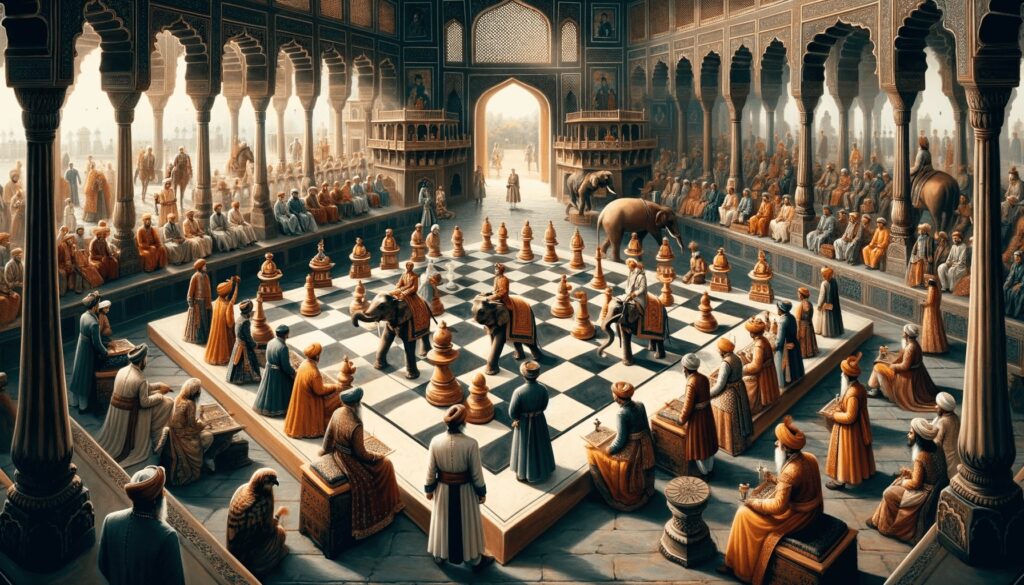The Mughal Empire: Playing Chess with Live Pieces
December 1, 2023
The Mughal Empire, which thrived in India from the 16th to the 19th century, was a marvel of opulence and culture. Beyond its grand palaces and architectural wonders, it also cultivated a rich tradition of chess. Within the heart of this magnificent empire, chess flourished not merely as a game of strategy but as a symbol of cultural significance. The Mughal courts, graced by illustrious emperors such as Akbar the Great, Jahangir, and Shah Jahan, became the epicenters of grand chess tournaments and spectacular displays of intellect and strategy.

The Mughal Empire: Playing Chess with Live Pieces – Cultural Heritage, Trained Animals, and Significant Moments
The Mughal Courts and Live Chess
The Mughal courts were not just arenas for political intrigue; they were stages for grand chess matches that transcended the confines of a standard chessboard. These games were extraordinary events where the elite of society gathered to witness chess in its most extravagant form. Courtiers, nobles, and high-ranking officials engaged in intense battles of intellect and strategy amidst the regal surroundings of the Mughal courts.
The intricately designed chess pieces, the strategies devised, and the precision of each move combined to create a dazzling display of intellect and entertainment. The Mughal courts played a pivotal role in promoting chess as both a game and a cultural phenomenon, leaving an indelible mark on the heritage of the empire.
Large Chessboards and Live Figures
Imagine a chessboard that spans an entire room, adorned with life-sized pieces that move at the command of the players. This was the captivating spectacle of playing chess with live figures in the Mughal Empire. The games took place on massive boards, often set on the ground to accommodate the grandeur of the occasion.
These boards were not just playing surfaces; they were stages for the drama of chess. The pieces, represented by living individuals, were directed by courtiers or servants, making their moves according to the rules of the game. The sight of knights, kings, and queens, embodied by living actors, added an element of theater to the already intense competition.
The intricacies of the game, the elegant moves, and the sheer scale of the chessboards left spectators in awe. These events were not just about competition; they were about showcasing the beauty and complexity of chess as a form of artistic expression.
Cultural and Social Significance
In the Mughal Empire, chess was not just a pastime; it held a profound cultural and social significance. The game of chess served as a symbol of intellect and strategy, qualities highly valued in Mughal society.
Playing chess with live figures was an activity that transcended mere entertainment. It was a reflection of the empire’s admiration for intellectual pursuits and a testament to the sophistication of its elite. The Mughal rulers themselves often participated in these games, emphasizing the importance they placed on the game of kings.
Moreover, chess provided a platform for social interaction and diplomacy. It was a means for courtiers and officials to engage with their rulers on a level playing field, fostering camaraderie and mutual respect.
The game also played a role in the broader cultural tapestry of the Mughal Empire. It was depicted in art, literature, and poetry, further cementing its place as a cultural treasure. The Mughal fascination with chess endured, leaving a legacy that continues to be celebrated today.
Personal Beliefs and Character
Botvinnik, an electrical engineer by profession, was a staunch supporter of the Soviet system and often melded his scientific background with his chess teachings. He believed in the combination of innate talent and hard work, and he often advocated for a blend of human intuition with the precision of machine analysis in the game. This belief made him one of the early pioneers in computer chess.
In character, Botvinnik was known for his determination, discipline, and unwavering belief in his methods. He was not just a player but also a theorist, teacher, and a driving force behind the growth of chess as a respected discipline in the Soviet Union.
Participation of Trained Animals in Playing Chess with Live Figures
The Mughal Empire’s love for spectacle and grandeur extended to the inclusion of trained animals in the tradition of playing chess with live figures. These magnificent creatures added an extraordinary dimension to an already captivating game.
Trained elephants, the gentle giants of the animal kingdom, were among the stars of these chess spectacles. They were meticulously trained to move chess pieces on enormous boards, drawing gasps of wonder from the audience. The sight of these majestic creatures maneuvering knights and rooks added an unforgettable touch to the proceedings.
Horses, with their grace and agility, were also a part of the chess-playing experience. They showcased their dexterity by executing moves on the board, embodying the spirit of the game.
Birds, including falcons and eagles, soared above the chessboard or were incorporated into the scenery, enhancing the overall ambiance. Their presence added an air of extravagance and luxury to these grand events.
The participation of trained animals in playing chess with live figures was a testament to the Mughal Empire’s commitment to creating unforgettable and awe-inspiring experiences. It underscored the empire’s reverence for both chess and the performing arts, leaving a legacy of grandeur that continues to captivate our imaginations.
In summary, the Mughal Empire’s tradition of playing chess with live figures, enriched by its grand courts, colossal chessboards, cultural significance, and the involvement of trained animals, remains a testament to the empire’s cultural heritage and its enduring impact on the world of chess and entertainment.
